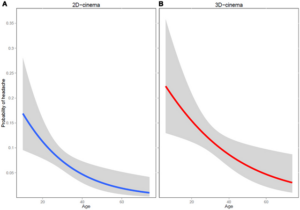Researchers from University of Tartu (Tartu, Estonia) have investigated the link between 3D movies and the occurrence of headaches. Although there have been a few previous reports on this subject, the team stated that the significance of this study derives, in part, because the question of such a link has never been the target of a specific and systematic investigation.

The study was supported by the Estonian Headache Society. The results were published in an article on March 23, 2016 entitled “3D Cinema and Headache: The First Evidential Relation and Analysis of Involved Factors.” The article can be found on-line at http://tinyurl.com/jfsy4z8
The study is described as “prospective, non-randomized, observational study.” In the study, 6,000 questionnaires were distributed to consecutive cinema visitors. Relative headache risks for 2D vs. 3D movie visitors and the effects of background variables were analyzed.
Participants in the study were asked to fill in the questionnaire after watching the movie. The questionnaire included questions on the following topics:
- Demographic data.
- Information about the movie theater (including location of the visitor’s seat).
- Information about the movie itself (including weekday and time of viewing).
- The 3D technology (passive or active).
- Headache history.
- Presence of other possible headache triggers immediately before the movie.
- In case of an occurrence of a headache, several additional questions were asked.
- Headache onset, time and duration.
- Headache location.
- Other headache characteristics.
- Premonitory and/or accompanying symptoms.
- Treatment used – if any.
The questionnaire was filled out and returned by 1293 persons. The mean age of responders was 33. The results of the study include a vast amount of statistical data. It can be anecdotally summarized as follows.
- 3D movies can provoke headaches.
- Individuals who viewed 3D movies reported headache during or after the movie 1.61 times more often than 2D movie viewers.
- The risk was higher in women
- People at risk are mostly younger.
- Among 3D movie visitors, those with a previous history of headaches were 4.17 times more prone to get a cinema-induced headache.
- The risk was the highest for persons with a history of migraine headaches.
Other conclusion of this study include the following:
- Active 3D technology was associated with a 2.2 times higher probability of inducing a headache than passive technology – but, this association was not statistically significant.
- The distance of the viewer from the screen when viewing a 3D movie is a factor in inducing a headache. Viewing a 3D movie from the front third of a theater represents a higher probability of developing headache. (It is noted that, in 2D movies, the seating had no difference to the risk of developing a headache.)
Several other possibly related factors were also investigated that showed no significant relations to the probability of headache development. These included the genre of the movie, the weekday and the time of visit to the theater. Occurrence of headache was not related to a persons’ education, usage of glasses or contact lenses, visiting the movie on an empty stomach, thirst, or consumption of various foods or beverages, including caffeine, alcohol and narcotics prior to the movie. -Arthur Berman
Mark Braschinsky, [email protected]

